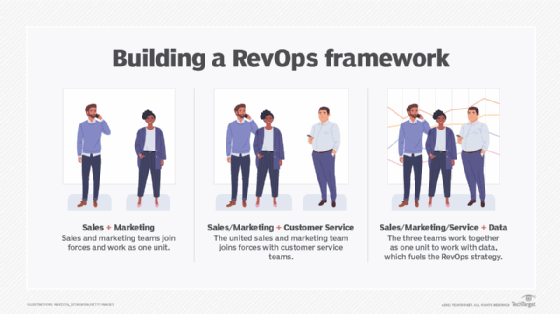revenue operations (RevOps)
What is revenue operations (RevOps)?
Revenue operations (RevOps) is the strategic integration of sales, marketing and service departments to provide a better end-to-end view to administration and management, while leaving day-to-day processes within the departments. The holistic approach of RevOps is designed to break down silos between departments.
As digital customer experience (CX) evolves, the need for various departments to share information has grown; RevOps is the strategy to bring them all together and more precisely measure the ROI in those departments.
What role does RevOps play in businesses?
A RevOps team or approach can act as the central hub for customer information for the organization, with a focus on customer acquisition, bookings, recurring revenue, customer churn and satisfaction and other customer-centric metrics. IT enables RevOps with tools such as analytics and AI to discover both trends and opportunities driving revenue streams.
Unlike other similarly named strategies, like business operations or sales operations, RevOps focuses on revenue growth, which can include sales operations but also ties in other customer-facing departments, such as marketing and service.
What revenue operations doesn't include is departments that are more internal, such as HR or the legal department. RevOps facilitates collaboration between departments that have a direct effect on a company's or organization's revenue.
The importance of RevOps
The introduction of RevOps as a term and strategy is tied directly to a changing landscape of how organizations market, sell and serve their customers.
Customers expect positive online experiences. They also expect companies to know about previous interactions and inquiries, without having to repeat details over the course of multiple interactions. Thus, connecting sales, marketing and service teams through RevOps is a method to meet those customer expectations.
With customer information coming from more touchpoints than ever before, RevOps teams or administrators are tasked with making that data and information collection easy and transparent -- using both technology and organizational strategy.
RevOps ties directly to an organization's data, which continues to grow in importance. The main goal of revenue operations is to connect data from sales, marketing and service departments to help provide a better 360-degree customer view before, during and after the sale.
The RevOps framework
Organizations are starting to incorporate RevOps teams or executives to help manage this strategic coming together of various departments. A company like Salesforce has a RevOps department and an executive reporting to its chief financial officer (CFO).
Other methods of a RevOps framework can include an administrative team, such as management from sales, marketing and service. Other companies have begun adding a chief revenue officer that either reports to the CFO or CEO.

Software vendors create technology and tools to make it easier for organizations to break down silos within various departments and to better share data and information across the customer-facing departments. Companies like InsightSquared and Salesforce have tools that claim to improve data integration between departments and remove those silos.
While RevOps helps bring together sales, marketing and service departments, it can vary depending on the organization as to where the primary focus is for the RevOps team. Some organizations will focus more on marketing operations to drive revenue, while others will determine more emphasis needs to be put on sales prospecting, and others will determine that the service department needs to improve its upsell and cross-sell capabilities.
Benefits of RevOps
Beyond driving better revenue growth for the organization, the addition of a RevOps team or strategy has other benefits for businesses. Those include the following:
- Alignment. Bringing customer-facing departments together ensures every campaign and customer initiative has a measurable outcome on the sales funnel from the start of the campaign to post-sale service needs.
- Creating focus. By bringing together sales, marketing and service, organizations can focus goals across the departments and get each group on the same page with the same endpoint in mind, such as generating leads, closing deals and expanding existing accounts.
- Simplification. By establishing a RevOps approach, organizations can remove roadblocks and silos within departments, increasing companywide efficiency and creating better CX.
Editor's note: This article was written by Jesse Scardina in 2018. TechTarget editors revised it in 2022 to improve the reader experience.







